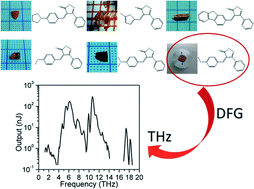Molecular design on isoxazolone-based derivatives with large second-order harmonic generation effect and terahertz wave generation†
Abstract
A series of 3-phenyl-5-isoxazolone and 3-methyl-5-isoxazolone-based compounds with different electron donors were synthesized. Fourteen single crystals in this family were obtained by slow evaporation. Single crystal X-ray studies showed that four new 3-phenyl-5-isoxazolone-based crystals, C20H18N2O2 (PDI), C15H11NO2S (PTI), C23H15NO2 (PFI), and C17H13NO2S (PMI-(I)), belong to the noncentrosymmertric space group. The inclinations to achieve noncentrosymmetric space groups in the 3-phenyl-5-isoxazolone-based crystals have been confirmed by first-principles calculations. Powder second harmonic generation (SHG) tests revealed that the abovementioned four acentric crystals exhibited very large SHG intensities that were about 1 to 3 times that of OH1 (a commonly used nonlinear optical crystal) under 2.09 μm light. Their UV-vis absorption, diffuse reflectance spectroscopy, and thermal properties were also characterized. Moreover, widely tunable and monochromatic terahertz difference frequency generation in the 3-phenyl-5-isoxazolone-based crystal C17H13NO3 (MLS) was realized for the first time.


 Please wait while we load your content...
Please wait while we load your content...